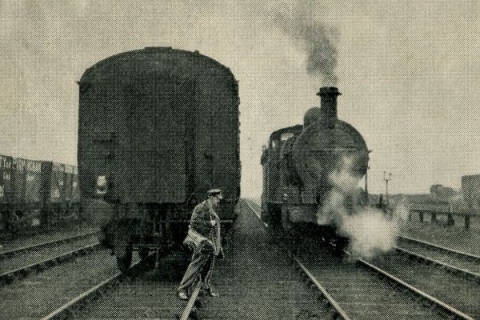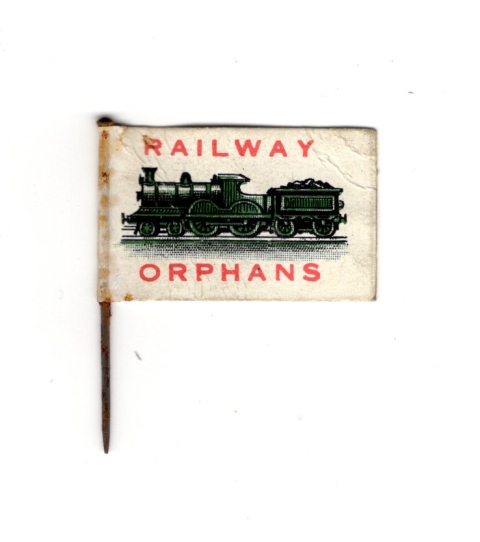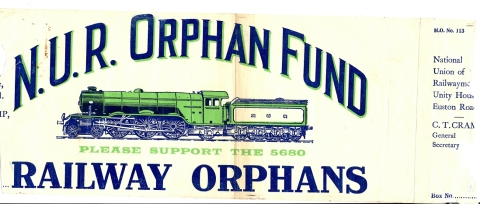

The records show improbable jobs like ‘seat dresser’ and ‘waker up’, to questionable compensation to injured works. It enables us to see these people not as a statistic but as individuals.
28 March 2023
5 minutes
A major new historical record of 25,000 railway worker accidents and how they were supported by trade unions has been released to the public.
The records provide details about accidents to railway staff in Great Britain and Ireland from 1889 to 1920, including who was involved, what they were doing on the railways, what happened to them and how they and their families were provided for after the accident.
The cases come from the records of one of the key railway trade unions - the Amalgamated Society of Railway Servants (ASRS)/ National Union of Railwaymen (NUR) – which has since become part of the RMT Union. They detail the support provided to Union members after an accident, ill-health or old age, such as compensation secured or payments from the orphan fund.

A flag sold c.1917 to raise money for the orphan fund. Courtesy Railway Work, Life & Death project.
It is part of the 'Railway Work, Life & Death' project, a collaboration between the University of Portsmouth, the National Railway Museum and the Modern Records Centre at the University of Warwick. The project aims to improve our knowledge and understanding of British and Irish railway worker accidents from the late 19th century to the start of the Second World War.
Dr Mike Esbester, Senior Lecturer in History at the University of Portsmouth and one of the project leads, said: “This major update to the project database, doubling its size, takes us back into the 19th century, which is new ground for the project. This is the first time ever that information about the health of railway workers has been available and provides a fuller picture of accidents and their impact on individuals and their families.
“Having these records is important as they give us insight into what was being done to keep the railways running, working practices, worker health, worker families and the impacts of accidents. It enables us to see these people not as a statistic but as individuals.”

A wrapper for a collecting tin, again for the orphan fund, from the early 1930s. Courtesy Railway Work, Life & Death project.
Volunteers from the Modern Records Centre at the University of Warwick (where the records are kept) and at the National Railway Museum transcribed records of around 25,000 reports. They’ve extracted the details found in the documents – things like names, ages, roles, companies and details of the Union’s support – and entered them into the database.
In this latest phase of the project, we see the story of the place of women in the union, joining during the First World War, with some staying on afterwards. On 4 May 1917, crane driver Mrs Clarksen was at work in Southport goods warehouse, when she fell out of the cage of the crane and was killed.
The records show the wide range of jobs of railway staff, from traditional roles such as boilermaker, iron moulder, driver, fireman, guard, ticket collector and signalwoman to some that seem improbable such as chair dresser, fish checker and waker up.
We also see the important role of the Union bargaining to increase compensation. On 1 January 1889, London and North Western Railway employee Mr Driver suffered 'terrible injuries' when hit by a train in Battersea. Compensation wasn't paid routinely at that point, so the Union had to fight for it every time - in this case getting the value up from the £25 originally offered to £70. However, he was 'in great straits so under pressure accepted the sum here’.
This major update to the project database, doubling its size, takes us back into the 19th century, which is new ground for the project. This is the first time ever that information about the health of railway workers has been available and provides a fuller picture of accidents and their impact on individuals and their families.
Dr Mike Esbester, Senior Lecturer in History
There is also the case of engine driver R Morris on the Taff Vale Railway, who joined on 28 July 1872 and was a member of the Union's Aberdare branch. He retired due to age on 17 November 1908, receiving a grant of £30 from the disablement fund. He appears in the death fund having died on 11 January 1909 of ‘senile decay.’
Karen Baker, Library Manager at the National Railway Museum and part of the lead research team, said: “As a museum, we’re delighted that we can support this fascinating project which uncovers an important portion of history not previously explored. Our team at the National Railway Museum, alongside colleagues at University of Portsmouth and the Modern Records Centre at the University of Warwick, have worked incredibly hard to deliver this piece of research and we’re thrilled to be able to release its findings.”
This is the latest dataset released by the project, which started in 2016. Since then, it has had over 14,000 downloads worldwide of its existing data - around 23,000 cases.
Having these records is important as they give us insight into what was being done to keep the railways running, working practices, worker health, worker families and the impacts of accidents. It enables us to see these people not as a statistic but as individuals.
Dr Mike Esbester, Senior Lecturer in History
The new data release for the Railway Work, Life & Death project took place at Unity House (RMT headquarters) on Monday 27 March at 12 noon.
Dr Esbester added: “We think this work will be of great interest to all sorts of people: railway enthusiasts, family historians, railway museums and heritage centres, archives, the current railway industry and academics.”
The database is available, free, on this website, so anyone who’s interested can easily learn more about work and accidents on Britain and Ireland’s railways from the later 19th century until the Second World War.
You can also follow the project on Facebook and Twitter, too: @RWLDproject

The new data release for the Railway Work, Life & Death project took place at Unity House (RMT headquarters) L-R: Sarah Friday (RMT), James King (Modern Records Centre), Karen Baker (National Railway Museum), Mike Esbester (University of Portsmouth), Chris Jolliffe (Modern Records Centre), Alex Gordon (RMT), Mick Lynch (RMT), Stephen Lamb (MRC), Daisy Turnbull (University of Portsmouth), Jonathan Havard (RMT), Eddie Dempsey (RMT). Credit RMT Union.
